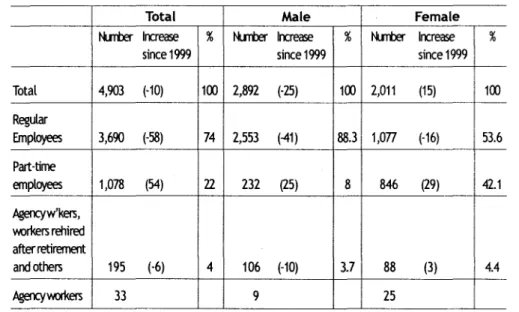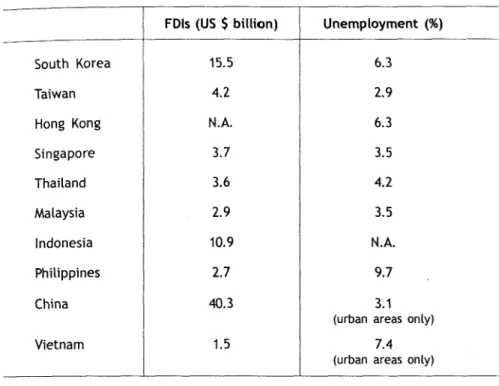During the 1970s and 1980s, most East and Southeast Asian economies became destinations for Japanese foreign direct investment. Chinese exports have displaced the labor-intensive exports of these economies on the world market. Mexico's biggest competitor in the world's largest apparel market, the United States, is China.
In more sophisticated products, China is likely to increase its capacity and share of global markets, sometimes at the expense of Asian exporters. In the case of the Philippines and Indonesia, the decline in tourism revenues was exacerbated by political instability in these countries. The queues of the unemployed are a good breeding ground for any social unrest anywhere in the world.
Xiagang workers are those who are laid off as a result of privatization or restructuring in state-owned enterprises or SOEs. Many of the skilled migrant workers and professionals are in the IT industry (eg, programmers), engineering, construction, and medical services.

A Comparative Study of Chinese Education in the
The Chinese in Malaysia are more diverse in terms of the dialect groups they belong to than those in the Philippines. On the other hand, 90 percent of Chinese in the Philippines can trace their ancestry to the Minnan region (southern Fujian), while 70 percent come from the Quanzhou area. An important factor that distinguished the ability of the Chinese in Malaysia and the Philippines in terms of political participation is the issue of citizenship.
Instead, the state's discriminatory policies contributed to the Chinese's patriotic sentiment towards China. With this development, being Chinese Filipinos began to remain in the consciousness of the majority of the ethnic Chinese. The development of Chinese schools in the early part of the 20th century reflects the gradual process of Chinese settlement in Southeast Asia.
At first it was under the direct supervision of the Chinese Consulate General and later under the supervision of the Chinese Embassy. This also reinforced the desire of Chinese community leaders in the Philippines for a highly China-focused Chinese curriculum that included the teaching of Chinese. In the Philippines, the approach to Chinese education since 1955 shifted from increased control of schools to their nationalization.
Even before the Filipinization of Chinese education in the Philippines, there were already debates about the direction and focus of the Chinese schools within the country's Chinese community. The strong commitment and unity of the Chinese community in Malaya played an important role in the struggle for the teaching of the Chinese language. The discussion ended with the establishment of the United Chinese Schools Teachers' Association (Jjaozong in Chinese).
Despite the nationalization of Chinese high schools, the unity and undying effort of the Chinese community pushed on. 34;The Three Major Problems of Chinese Language Education in the Philippines," in Teresita Ang-See and Lily Chua (eds.). Chinese).
Preventive Diplomacy in the
Asia Pacific: Challenges and Prospects for the ASEAN Regional Forum*
This memorandum contained recommendations on the future development of the ARF, with many such recommendations relating to the ARF's evolution towards a phase of preventive diplomacy. It is therefore not pragmatic for the ARF to wait until confidence-building measures have been exhausted before promoting preventive diplomatic measures. The specific features of the ARF “reflect the main arguments of the ASEAN-ISIS proposal for this initiative” (Hernandez, 1995).
These include the ARF-sponsored Seminars on Preventive Diplomacy, held in Seoul, Korea (May 1995); in Paris, France (November 1996); and in Singapore (September 1997). According to the document on Concept and Principles of Preventive Diplomacy, adopted by the ministers of the ARF participating states, preventive diplomacy is. Of the four proposals for preventive diplomacy measures that the ARF could undertake, all contain elements of CBMs and preventive diplomacy.
Second, the reluctance of some ARF participants to engage in the promotion of preventive diplomacy may be partly a consequence of the apparent asymmetry between the ARF's membership and its geographic footprint. For example, the principle of non-interference in the internal affairs of a state, if adopted as a principle of preventive diplomacy, would limit the ARF's capacity to undertake preventive diplomacy. The first concerns the continued viability of the ASEAN Way being adopted and applied in the ARF, which is more diverse.
As a result, these states continue to have reservations about AFSH taking a more proactive role in promoting preventive diplomacy measures. Therefore, in the case of ASH, there is a need to further increase the role of the President of ASH. The increased role of the ASF Chair, however, undermines the issues of sharing ASEAN's chairmanship with non-ASEAN participants in the ARF.
In his enhanced role, the ARF President needs more help from other ARF participants. It would therefore be beneficial for the ARF to establish a Regional Risk Reduction Center (RRRC) that could "effectively collect information and provide analysis to plan for danger points and assess [the potential for conflict] before a crisis occurs" (Tay, 1997). ). 34; The Future of ARF and CSCAP in the Regional Security Architecture.” Managing Security and Peace in the Asia-Pacific Eds.
The China Challenge to ASEAN Solidarity
The Case of the South China Sea Disputes
Beyond the end of the Cold War itself, there have been changes in the strategic environment that directly affect the nature of the disputes. China initially took a lukewarm attitude to the Manila Declaration on the South China Sea, but later stated that it appreciated some of the principles contained in the document. A major point of contention was Vietnam's demand that the Paracels be included in the geographic scope of the code.
The Joint Consultative Draft of the Regional Code of Conduct was discussed again in October 2000 in Hanoi. Second, in terms of conflict prevention or dispute resolution, whether it is better to deal with China bilaterally or multilaterally. ASEAN increasingly recognizes China's inevitable influence in its part of the world.
Another illuminating example of the differences in the positions of the ASEA claimants concerned a Philippine proposal to include the South China Sea disputes on the agenda of the Asia-Europe meeting in March 1999. Ultimately, ASEA supported the proposal. position of the Philippines, the issue was raised during ASE~1, but also China. The Philippines has been the most vocal in advocating a common position from ASEAN on the issue of the disputes.
Many of the ASEAN countries still harbor long mutual suspicions left over from history. Therefore, the issue of ASEAN unity will remain important regardless of the status of disputes in the South China Sea. ASEAN itself continues to have second thoughts about the role of the United States in the post-Cold War order.
It will rely less on power-balancing behavior and on US security guarantees.
Southwest Pacific Dialogue
Indonesia's Newest Leverage in the Asia Pacific*
The Asia-Pacific region has thus been Indonesia's most important diplomatic arena, with Indonesia initiating and participating in many cooperative arrangements and organizations in the region. The idea of establishing a forum for the \Vest Pacific was particularly significant in light of three important changes that occurred on the political and economic landscapes of the Asia-Pacific region (Shihab, 2001). Secondly, the separatist movements in the region have been a direct threat to the stability of the region as well as to good bilateral relations between affected countries.
As a demonstration, six ministers met in the royal city of Jogjakarta on October 5, 2002 to discuss the programs and strategies of the SwPD. At the end of their meeting, they signed a declaration on the creation of a new forum in the South West. Pacific Region (Southwest Pacific Dialogue 2003). Australia, New Zealand and the smaller Pacific states are Papua's closest neighbors (Shihab, 200 I).
As for Indonesia, close cooperation with the South-West Pacific countries has been an important foreign policy guideline in the Guidelines of State Policy since 1978 (Alatas, 200 l). The forum is also expected to have a positive impact on the countries' bilateral relations. of the region in the context of promoting peace and security. Three of the Southwest Pacific countries have land borders where bilateral interactions could be difficult to manage if insurgents from both sides operate in those border areas, as in the cases of Papua New Guinea and Indonesia.
Such a gesture supports Indonesia's aim to create a positive image as well as increase mutual understanding between countries in the Southwest Pacific area. Address at an International Seminar on Identifying Challenges and Opportunities in the Western Pacific Region: Is There a Need for an !Orum?Jakarta, Australian Studies Centre, University of Indonesia. 34;Identifying Challenges and Opportunities in the Western Pacific Region: Is There a Need for a New Forum?
Keynote Address at an International Seminar on Identifying Challenges and Opportunities in the Western Pacific Region: Is_there a Need !Or a New Forum.
The Contributors
Quilop is Assistant Professor of Political Science at the University of the Philippines-Diliman; Senior researcher/. Analyst at the Office of Strategic and Special Studies, Armed Forces of the Philippines; and research fellow at the Institute for Strategic and Development Studies. Santarita is an Instructor 5 in History, Department of Social Sciences, University of the Philippines in the Visayas, Miagao, Iloilo.
He was one of the Filipino delegates to the first Southwest Pacific Dialogue Cultural Scholarship held in Bandung and Jogjakarta, Indonesia last May-August 2003. Santarita is currently completing his Master of Arts in Asian Studies with Indonesia as a country of specialization. Space and Identity: Expression in Muslim Culture, Art and Society in the Philippines.

